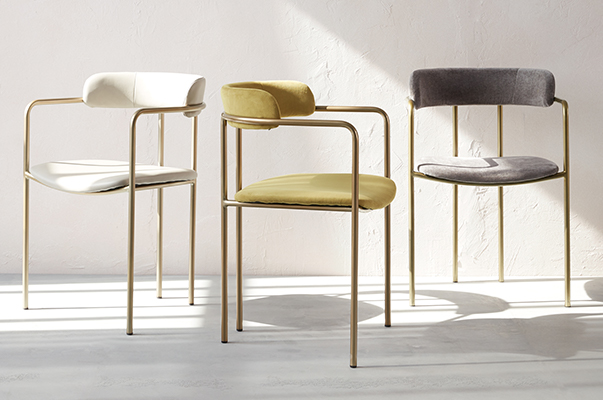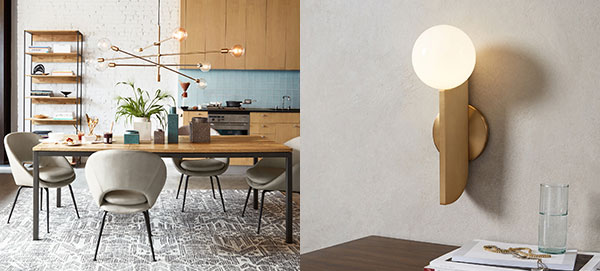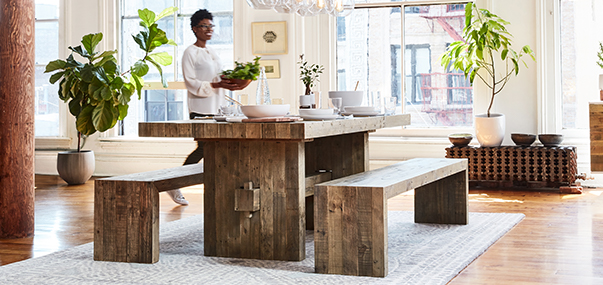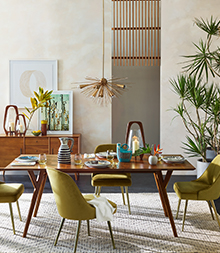Rules Of Thumb: Dining Room
As you're decorating your dining room, it helps to have some handy rules of thumb. Here's what the pros know that can help you get it right.

DINING TABLES
- Allow 36"-44" from table to wall on each side to have room to pull out chairs. (Allow 54"-62" from table to wall if you want room for a buffet.)
- Round tables are great for square rooms and small spaces, or to foster conversation. They can usually fit more people because there are no corners.
As a rule of thumb:- A 42"-48"-diameter table seats 4
- A 60" table seats 6-8
- Allow about 2' per person at a rectangular table, though you can squeeze in more chairs when needed. Bench seating also works well at rectangular tables, and benches can be tucked under the table when not in use, to create more room.
As a rule of thumb:- A 48"-long table seats 4
- A 60"-72" table seats 6
- An 80"-87" table seats 8
- A 92"-108" table seats 10
- A 120" table seats 12
- Pedestal tables can fit a little more seating because there aren't table legs taking up space.
- Dining tables are typically 30" high, which is also the standard height of most desks, so a dining table can easily double as a desk, and vice versa.

CHAIRS
- Dining chair seats are usually 18"-19" high, but if you want to use armchairs or larger host chairs at your table, measure first to make sure they'll fit comfortably under the table, especially if your dining table has an apron.
- Upholstered dining chairs are generally most comfortable, but look for durable, easy-to-clean fabrics in mid-range or heathered colors that won't show stains. Wood or leather are durable and easy to keep clean.
- Don't be afraid to mix chairs, placing armchairs or upholstered host chairs at the ends of the table.

LIGHTING
- Center a chandelier or pendant on the table, not the room.
- Hang it so the bottom of the light fixture is 30"-36" above the table (32" on average).
- Choose a chandelier about half the width of your dining table. Another rule of thumb is to add the room's length and width in feet. That number in inches suggests a rough size for the diameter of your chandelier.
- Always put chandeliers and pendants on a dimmer if possible.
- For a long, rectangular table, multiple pendants or a linear fixture may work better than a round chandelier.
- Don't limit dining room lighting to chandeliers. Wall sconces will add ambient lighting around the perimeter of the room, and slender table lamps can also work well on a buffet or console table.
- Hang sconces about 60"-64" above the floor (measuring from the center of the back plate), depending on your ceiling height. Allow at least 24"-36" and optimally, 48" between a pair of sconces.

AREA RUGS
- Allow at least 36" from the edge of your table to the edge of the rug, for room to pull out chairs. (Most dining tables will need a rug that's at least 8' wide.)
- Allow at least 12" between the rug and wall if possible.
- Flatweave rugs are a good choice for dining rooms. Tufted and low-pile rugs can also work well, but avoid shags and thick piles that will catch crumbs and be harder to clean. Natural fibers such as sisal can also be harder to clean if there are spills.
DECORATING TIPS
- Keep centerpieces 15" or lower so diners can see each other across the table.
- Balance windows or a large piece of furniture with a large piece of art or mirror on the opposite wall.


